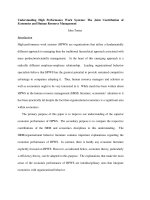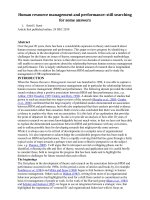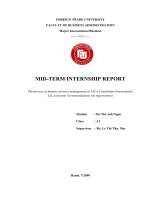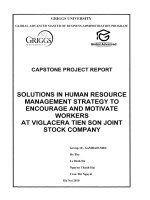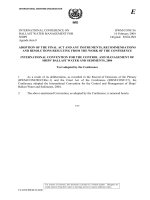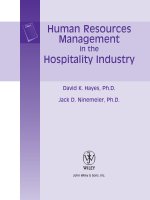human resource management for the hospitality and tourism industries 0750665726
Bạn đang xem bản rút gọn của tài liệu. Xem và tải ngay bản đầy đủ của tài liệu tại đây (2.28 MB, 320 trang )
HUMAN RESOURCE
MANAGEMENT FOR THE
HOSPITALITY AND
TOURISM INDUSTRIES
This page intentionally left blank
HUMAN
RESOURCE
MANAGEMENT
FOR THE
HOSPITALITY
AND TOURISM
INDUSTRIES
Dennis Nickson
Deputy Head of Department, Department of Human Resource
Management, Strathclyde Business School, University
of Strathclyde, Glasgow, Scotland
AMSTERDAM • BOSTON • HEIDELBERG • LONDON • NEW YORK • OXFORD
PARIS • SAN DIEGO • SAN FRANCISCO • SINGAPORE • SYDNEY • TOKYO
Butterworth-Heinemann is an imprint of Elsevier
Butterworth-Heinemann is an imprint of Elsevier
Linacre House, Jordan Hill, Oxford OX2 8DP
30 Corporate Drive, Suite 400, Burlington, MA 01803, USA
Copyright © 2007, Dennis Nickson. Published by Elsevier Ltd. All rights reserved
The right of Dennis Nickson to be identified as the author of this work has been asserted in
accordance with the Copyright, Designs and Patents Act 1988
No part of this publication may be reproduced, stored in a retrieval system or
transmitted in any form or by any means electronic, mechanical, photocopying,
recording or otherwise without the prior written permission of the publisher
Permissions may be sought directly from Elsevier’s Science & Technology Rights Department in
Oxford, UK; phone: (ϩ44) (0) 1865 843830; fax: (ϩ44) (0) 1865 853333; e-mail:
Alternatively you can submit your request online by visiting the Elsevier web site at
and selecting Obtaining permission to use Elsevier material
Notice
No responsibility is assumed by the publisher for any injury and/or damage to
persons or property as a matter of products liability, negligence or otherwise, or from any use or operation of any methods, products, instructions or ideas contained in the material herein.
British Library Cataloguing in Publication Data
A catalogue record for this book is available from the British Library
Library of Congress Cataloging in Publication Data
A catalog record for this book is available from the Library of Congress
ISBN–10: 0-7506-6572-6
ISBN–13: 978-0-7506-6572-8
For information on all Butterworth-Heinemann publications visit our
web site at
Typeset by Charon Tec Ltd (A Macmillan Company), Chennai, India
www.charontec.com
Printed and bound in Great Britain by MPG Books Ltd. Bodmin, Cornwall
Contents
List of figures
List of tables
List of abbreviations
Preface
Chapter 1
ix
x
xi
xiii
Human resource management and the tourism
and hospitality industry: An introduction
1
Introduction
2
What are the tourism and hospitality industries?
3
Who makes up the tourism and hospitality workforce?
A brief snapshot
What is HRM?
Models or reality?
6
7
15
The bad news … pessimistic views of HRM in tourism
and hospitality
17
The good news … best practice in tourism and
hospitality
Chapter 2
20
Where this book stands
21
Conclusion
22
References and further reading
23
Websites
24
International human resource management
26
Introduction
27
The emergence of IHRM
27
MNCs and HRM policies and practices in the tourism
and hospitality industry
Conclusion
44
46
References and further reading
47
Websites
49
v
vi
H R M H O S P I TA L I T Y A N D T O U R I S M I N D U S T R I E S
Chapter 3
Chapter 4
Organizational culture
50
Introduction
51
In search of a definition
51
Competing views on organizational culture
53
How can we study organizational culture?
56
Organizational culture and HRM: a reprise
65
Conclusion
67
References and further reading
67
Websites
69
Labour markets
70
Introduction
71
Levels of analysis in the labour market
71
The internal labour market and the utilization of
flexible labour
Chapter 5
Chapter 6
80
Conclusions
85
References and further reading
85
Websites
86
Recruitment and selection
87
Introduction
88
Recruitment
90
Selection
104
Conclusion
111
References and further reading
111
Websites
113
Equal opportunities and managing diversity
114
Introduction
115
The employment experience of socially defined
minority groups
116
The legislative response
122
Managing diversity
133
Conclusion
137
References and further reading
138
Websites
139
CONTENTS
Chapter 7
vii
Training and development
141
Introduction
142
Understanding the context: national level responses
to training
Chapter 8
142
N/SVQs
146
Investors in people
147
Apprenticeships
151
Industry level
152
Training and development: no longer a dichotomy?
153
Conducting training
157
Conclusion
164
References and further reading
165
Websites
167
Performance management and performance appraisal
168
Introduction
169
The nature of performance management and
performance appraisal
Chapter 9
170
Appraisal in practice
172
Managing poor performance
185
Conclusion
186
References and further reading
186
Websites
187
Reward strategies in the tourism and hospitality
industry
188
Introduction
189
Employee and employer views of pay
189
Remuneration in tourism and hospitality
196
The practice of tipping
206
Fiddles and knock-offs
209
Other benefits
210
Conclusion
211
References and further reading
212
Websites
214
viii
H R M H O S P I TA L I T Y A N D T O U R I S M I N D U S T R I E S
Chapter 10 Employee relations, involvement and participation
Introduction
215
216
Employee or industrial relations?
217
Trade unions: in terminal decline?
222
Employee involvement and participation
228
Conclusion
237
References and further reading
238
Websites
240
Chapter 11 Welfare, health and safety
241
Introduction
242
Absence management
243
AIDS/HIV
247
Alcohol/drug misuse
252
Sexual harassment
256
Smoking
264
Stress
266
Working time
270
Workplace violence
273
Conclusion
274
References and further reading
275
Websites
278
Chapter 12 Grievance and disciplinary procedures
Introduction
279
280
Setting the scene on grievance and disciplinary
procedures
280
Conclusion
290
References and further reading
291
Websites
292
Chapter 13 Concluding comments
293
References
296
Index
297
List of figures
1.1 The HRM cycle
16
3.1 HRM and culture: contradictions and dilemmas
66
5.1 Sources of recruitment in the hospitality industry
102
7.1 The principles of the IiP standard
149
11.1 Some negative effects of stress for the individual and organization 267
12.1 Typical disciplinary procedure
286
ix
List of tables
2.1 A geocentric human resource profile
31
2.2 Advantages and disadvantages of using PCNs, TCNs and HCNs
34
4.1 Hotel demands variability
78
6.1 Anti-discriminatory legislation
123
6.2 Differences between managing diversity and equal opportunities
135
7.1 Levels of analysis for understanding approaches to training
and development
143
7.2 VET policies and practices in selected countries
144
8.1 Features of performance management
170
8.2 Criteria used to measure individual performance
181
9.1 How the UK NMW has evolved since 1999
204
9.2 Comparison of the level of the adult minimum wage across
selected countries, end 2004
205
10.1 Union density in selected countries
224
10.2 Direct communication and information sharing techniques
229
x
List of abbreviations
ACAS
AIDS
BA
BHA
CIPD
CEHR
CRE
DDA
DRC
DTI
EOC
EAP
ET
EU
EWC
HCN
HIV
HRD
HRM
HSE
ICE
IDS
IIP
IRS
IHRM
JCC
LPC
LRD
MNC
Advisory Conciliation and Arbitration Service
Acquired Immune Deficiency Syndrome
British Airways
British Hospitality Association
Chartered Institute of Personnel and Development
Commission for Equality and Human Rights
Commission for Racial Equality
Disability Discrimination Act
Disability Rights Commission
Department of Trade and Industry
Equal Opportunities Commission
Employee Assistance Programme
Employment Tribunal
European Union
European Works Councils
Host-Country Nationals
Human Immunodeficiency Virus
Human Resource Development
Human Resource Management
Health and Safety Executive
Information and Consultation of Employees Regulations 2004
(ICE Regulations)
Income Data Services
Investors in People
Industrial Relations Services
International Human Resource Management
Joint Consultative Committees
Low Pay Commission
Labour Research Department
Multinational Company
xi
xii
NMW
N/SVQ
PCN
QC
RFO
RRA
SSC
SDA
SME
TCN
TGWU
TQM
WERS
WTR
H R M H O S P I TA L I T Y A N D T O U R I S M I N D U S T R I E S
National Minimum Wage
National/Scottish Vocational Qualification
Parent-Country National
Quality Circles
Race for Opportunity
Race Relations Act
Sector Skills Council
Sex Discrimination Act
Small and Medium-sized Enterprise
Third-Country National
Transport and General Workers Union
Total Quality Management
Workplace Employment Relations Survey
Working Time Regulations
Preface
This book stems from a longstanding interest in how tourism and hospitality
organizations and managers seek to manage their employees. As a highly labourintensive industry, tourism and hospitality organizations are often heard to talk of
how their people are ‘their greatest asset’. However, even a cursory understanding
of the nature of work, employment and people management in tourism and hospitality points to the many paradoxes and contradictions that are apparent in
studying human resource management (HRM) in the sector. This book aims to
explore some of these paradoxes and contradictions in seeking to submit the cliché
of ‘our people are our greatest asset’ to critical scrutiny. That said, the book is in
many respects a standard HRM text for the tourism and hospitality sector, recognizably following the traditional concerns of organizations as to how they best
attract, maintain and develop an effective workforce.
In talking about tourism and hospitality the book is also aware of the many
debates about how the sector is best conceptualized. There are many common attributes that are associated with both hospitality and tourism activities, which could
encourage them to be seen synonymously. Equally though some would argue for distinctiveness between the two. Like most colleagues writing in this area the book
acknowledges these debates, whilst also at times rather fudging the distinction
between tourism and hospitality. In fudging what some might consider a largely
semantic debate it is important not to lose sight of the one thing that is clearly paramount in all organizations in tourism and hospitality: the need to deliver service to
customers and the need to manage people in such a way that they offer a quality service. The manner though in which organizations in different countries, cultures and
market niches address this issue may vary enormously and this difference sustains
many of the concerns outlined in this book. Indeed, an appreciation of culture – and
the importance of organizational culture in particular – is a strong, and hopefully
novel, feature for a book of this nature.
In attempting to understand the importance of context to explain HRM practices this book also aims to be international in its focus and its use of sources and
examples. Thus, whilst the primary focus of the book is the UK, there are numerous
xiii
xiv
H R M H O S P I TA L I T Y A N D T O U R I S M I N D U S T R I E S
examples from a variety of other countries across the world. The same point is also
true in terms of examples of organizational practice. A number of examples are
drawn from what is usually described as the commercial hospitality sector, which is
well served by research. Many of those activities which are more oriented towards
travel and tourism are also represented, though material of this nature is not quite so
voluminous. A further aspect of context is the need to understand the dynamic
and changing environment in which tourism and hospitality organizations operate.
Political, economic, social and technological changes significantly affect tourism and
hospitality organizations and the experience of work for those people who work in
the sector; and the book is cognizant of this point throughout. This dynamism is also
apparent with regard to emergent debates about new concepts which allow for an
appreciation of the changing nature of the employment experience of the tourism
and hospitality workforce. For example, work I have done with colleagues on aesthetic labour – how employees embody the tourism and hospitality product by
‘looking good’ or ‘sounding right’ – points to the manner in which organizations
increasingly take an interest in their employees’ appearance as a source of competitive advantage. This book is designed to provoke thought and debate about aesthetic labour and a myriad of other issues and encourage the readership to challenge
its conclusions and stimulate further reading and research.
As has already been stated this book is the culmination of a longstanding interest
in the area of tourism and hospitality employment, both as teacher and researcher. In
that sense it is also an opportunity to draw on many of the ideas and writings of innumerable students and colleagues who have influenced my thinking. In particular, I
would very much like to acknowledge a huge debt to the work of Tom Baum, Yvonne
Guerrier, Rosemary Lucas and Roy Wood. Over the years they have given freely of
their time, advice and ideas, and shaped many of the ideas expressed in this book. I
hope this book can take its place alongside the work of my illustrious colleagues in
encouraging students and practitioners to think about how to improve the working
lives of the many who rely on tourism and hospitality for their employment.
Chapter
1
Human resource
management and the
tourism and hospitality
industry: An
introduction
Chapter objectives
This chapter sets the scene for the book. It considers
the nature of the tourism and hospitality industry
and some of the approaches to managing people
adopted by organizations and how these approaches
can vary. Therefore the aims of this chapter are:
●
●
●
●
To recognize the importance of tourism and
hospitality as an employment sector.
To outline the diverse range of sub-sectors and
occupations within the broad heading of
tourism and hospitality.
To consider the nature of the workforce.
To review the range of models/theories
concerned with human resource management
(HRM) and how these might be applied to the
tourism and hospitality sector.
1
2
H R M H O S P I TA L I T Y A N D T O U R I S M I N D U S T R I E S
Introduction
The importance of tourism and hospitality employment in both developed and
developing countries is attested to by the World Travel and Tourism Council (WTTC),
who suggest that travel- and tourism-related activities account for over 230 million
jobs, or 8.7 per cent of jobs worldwide (WTTC, 2006). However, whilst the quantity
of jobs is unquestionable, the quality of many of these jobs is of great concern to academics and policy-makers alike. Despite the rhetoric of policy-makers and business
leaders that people are the industry’s most important asset, many remain unconvinced that such a view is borne out by empirical evidence. For example, Douglas
Coupland, the notable cultural commentator, has for many captured the zeitgeist
when he talks pejoratively of ‘McJob’ which he describes as, ‘A low-pay, low-prestige,
low-dignity, low-benefit, no-future job in the service sector. Frequently considered a
satisfying career choice by people who have never held one’ (Coupland, 1993: 5; and
see also Lindsay and McQuaid, 2004). MacDonald and Sirianni (1996) recognize the
challenges of living and working in a service society which, according to them, is
characterized by two kinds of service jobs: large numbers of low-skill, low-pay jobs
and a smaller number of high-skill, high-income jobs, with few jobs being in the
middle of these two extremes. Such a situation leads labour analysts to ask what
kinds of jobs are being produced and who is filling them. This point is also true for
the tourism and hospitality industry and it is important at the outset of this book to
add a caveat about the generalizability (or otherwise) of the conditions of tourism
and hospitality employment worldwide. Hence Baum (1995: 151) reflecting the
diversity of employment within the sector notes that:
In some geographical and sub-sector areas, tourism and hospitality provides
an attractive, high-status working environment with competitive pay and
conditions, which is in high demand in the labour force and benefits from
low staff turnover … The other side of the coin is one of poor conditions, low
pay, high staff turnover, problems in recruiting skills in a number of key
areas, a high level of labour drawn from socially disadvantaged groups, poor
status and the virtual absence of professionalism.
Organizations and managers in the tourism and hospitality industry face real challenges in recruiting, developing and maintaining a committed, competent, wellmanaged and well-motivated workforce which is focused on offering a high-quality
H R M A N D T H E T O U R I S M A N D H O S P I TA L I T Y I N D U S T RY
3
‘product’ to the increasingly demanding and discerning customer. This book seeks
to address some of the key human resource (HR) issues that have to be tackled in
order that organizations can maintain such an environment. To do so it will critically
review some of the problems which lead many to characterize tourism and hospitality employment as generally unrewarding and unappealing, whilst also considering
examples of good practice, important policy responses and models of HRM which
may offer cause for greater optimism in the way people are managed within the
tourism and hospitality industry.
What are the tourism and hospitality industries?
Many academics, industrialists and policy-makers have attempted to define the
nature of the tourism industry – and the place of the hospitality sub-sector within
this broader conceptualization – yet there is still no one commonly accepted definition. Hence, there are inherent problems seeking to define what is a large and
diverse sector, which means many of the activities may overlap, and could be
described as encompassing tourism and hospitality. For example, Lucas (2004) in
her recent work on employment relations in the hospitality and tourism industries
chose to talk in broad terms about the Hotel, Catering and Tourism Sector (HCTS).
This characterization of the HCTS recognizes that, in reality, many jobs in hospitality and tourism, ‘share common attributes and are associated with both hospitality and tourism activities’ (p. 4). Clearly, then, we should recognize the potential
for a lack of precision in describing the tourism and hospitality industries.
In an attempt to avoid too much imprecision and, at the same time, capture the
diversity of the sector this book uses the framework offered by People 1st, which
is the Sector Skills Council (SSC) for the hospitality, leisure, travel and tourism sector,
to exemplify the broad range of activities that may be seen in the HCTS. The reason
for using People 1st is that SSCs are the government-licensed bodies in the UK responsible for improving skills within the industry. SSCs are employer led and amongst
other things aim to be the voice of industry on skills matters and encourage best practice approaches to employment (and see Chapter 7 for the role of People 1st in improving skills and training in hospitality, leisure, travel and tourism). Therefore, People 1st
suggest that the sector as a whole is made up of 14 sub-sectors (People 1st, 2006):
●
●
hotels;
restaurants;
4
●
●
●
●
●
●
●
●
●
●
●
●
H R M H O S P I TA L I T Y A N D T O U R I S M I N D U S T R I E S
pubs, bars and night-clubs;
contract food service providers;
membership clubs;
events;
gambling;
travel services;
tourist services;
visitor attractions;
youth hostels;
holiday parks;
self-catering accommodation;
hospitality services.
Moreover within this broad classification of travel, tourism and hospitality there is
massive diversity in the types of jobs generated, in relation to their technical and
skills’ demands, educational requirements, terms and conditions and the type of
person that is likely to be attracted to employment in them. To illustrate this point
we can consider Baum’s (1997: 97–98) description of the range of people a person
buying a package holiday is likely to interact with:
●
●
●
●
●
●
●
●
●
●
●
●
●
the retail travel agent;
insurance companies;
ground transport to and from the airport;
at least two sets of airport handling agents (outbound and return);
airport services (shops, food and beverage outlets, bureaux de change) (outbound and return);
the airline on all legs of the journey;
immigration and customs services;
local ground transportation;
the hotel or apartment;
tour services at the destination;
companies and individuals selling a diversity of goods and services at the destination (retail, food and beverage, entertainment, cultural and heritage, financial,
etc.);
emergency services at the destination (medical, police, legal);
service providers on return (photography processing, medical).
H R M A N D T H E T O U R I S M A N D H O S P I TA L I T Y I N D U S T RY
5
Baum characterizes all of these possible intermediaries, and the interactions they
will have with the holiday maker, as crucial in ‘making or breaking the tourist
experience’. Thus while the physical product is important, for most tourists the
quality of their experience is likely to be also reliant to a large degree on the interactions they will have with the variety of front-line staff in the travel, tourism and
hospitality industry. These so-called ‘moments of truth’ (Carlzon, 1987) are therefore
crucial for organizational effectiveness, success, competitiveness and profitability.
Indeed, within an industry that is characterized by diversity and heterogeneity in
terms of the purpose, size, ownership and demands of the enterprise, the only real
point of homogeneity is delivering service to customers and the need to manage
people in such a way that they offer a quality service. The corollary of this point
would be the belief that such front-line staff would therefore be sufficiently well
paid, trained and motivated to offer outstanding service. The reality however is that
often such staff have the lowest status in the organization, are the least trained, and
are the poorest paid employees of the company.
In recognizing the diversity both of the range of sub-sectors and types of jobs
they are likely to generate, this book cannot consider all of these aspects in detail.
Indeed, more is known about employment in certain sub-sectors than others. For
example, the commercial hospitality industry encompassing hotels, restaurants
and pubs, bars and nightclubs is the largest sub-sector with around 70 per cent of
employees in the UK (People 1st, 2006). Unsurprisingly, then, the commercial hospitality industry is well served with extensive research on the nature of employment and HRM strategies (D’Annunzio-Green et al., 2002; Lucas, 2004). On the
other hand, little has been written on the events industry or the nature of HRM in
youth hostels, for example. As a consequence many of the examples drawn on in
this book are from the commercial hospitality industry, although, where possible,
illustrations of organizational practice from travel and tourism organizations are
also used. Ultimately, the main aim of the book is to attempt to understand the
potentially diverse employment experience of those working in what we will
broadly think of as the tourism and hospitality industries. Thus, how does the
experience of an airline flight attendant differ from that of a pot washer in the
kitchen in a small restaurant to a receptionist in the front desk of an international
hotel or to a tour rep working on an 18–30-type holiday?
A further issue to consider is the manner in which the sector is heterogeneous
in terms of the predominance of small- and medium-sized enterprises (SMEs).
People 1st (2006) note that within the UK hospitality, leisure, travel and tourism
6
H R M H O S P I TA L I T Y A N D T O U R I S M I N D U S T R I E S
sector 76 per cent of establishments employ fewer than ten people and 50 per cent
fewer than five. Heterogeneity is also seen in relation to the way that organizations
adopt differing routes to competitive advantage, depending on which type of market they operate in. For example, full service carriers in the airline industry are
likely to have very different approaches to HRM compared to low-cost airlines
(Eaton, 2001; Spiess and Waring, 2005). The same is true for the hospitality sector,
which may range from first class and luxury hotels providing extravagant, full
24-hour service to the more homely comforts of a bed and breakfast establishment;
from fast food restaurants to Michelin starred restaurants. In turn, the jobs provided by these various organizations demand a variety of skills and attributes
from those employees interacting with customers, which again will impact on
HR strategies such as recruitment and selection and training.
Who makes up the tourism and hospitality
workforce? A brief snapshot
The International Labour Organization (ILO, 2001) in their wide-ranging report
on the global tourism and hospitality industry provides evidence that suggests
that the industry globally is largely reliant on what Wood (1997) has described as
so-called ‘marginal workers’, such as women, young workers, casual employees,
students, relatively high numbers of part-timers and migrant workers. For example,
within the UK women make up around 58 per cent of the broader hospitality,
leisure, travel and tourism workforce (People 1st, 2006). More specifically, the hospitality sub-sector is indicative of the broader sector in having a higher proportion
of part-time employees (52 per cent) than most other industries with the all industry figure being 25 per cent (HtF, 2003). Young people are also prominent within
the hospitality, leisure, travel and tourism sector. For example, 37 per cent of the
total UK workforce is under 24 years and 58 per cent under 34 years (People 1st,
2006). Related to this last point a significant part of the tourism and hospitality
workforce consists of student, seasonal and migrant workers. Students are an
increasingly important segment of the labour market for hospitality and tourism
organizations (ILO, 2001). They are prepared to work for low wages and be flexible in their working patterns (Canny, 2002), creating what Curtis and Lucas (2001)
describe as a ‘coincidence of needs’ between employers and students. Thus, nearly
three quarters of all students who are working are employed in the retail and
H R M A N D T H E T O U R I S M A N D H O S P I TA L I T Y I N D U S T RY
7
hospitality industries and the vast majority of students who are working do so in
front-line jobs such as sales assistants, waiters/waitresses and check out operators
(Curtis and Lucas, 2001; Canny, 2002). The number of ethnic minority workers in
the broader hospitality, leisure, travel and tourism sector is 11 per cent, slightly
higher than the all industry figure of 9.6 per cent (People 1st, 2006). With regard
to qualifications only 12 per cent of employees in hospitality, leisure, travel and
tourism have a degree or equivalent compared to an all industry figure of 29 per cent,
with 15 per cent of the workforce having no qualification compared to 11 per cent
of the total workforce (People 1st, 2006).
Review and reflect
If you are currently working in the tourism and hospitality industry whilst completing your
studies list what you consider good and bad aspects of your job and your reasons for this.
Having briefly considered the nature of the hospitality and tourism industry and
the characteristics of its workforce attention now turns to understanding HRM
and the increasingly important role it is felt to play in organizational success.
What is HRM?
Definitions of HRM
There have been many attempts to define what exactly HRM might be and indeed
Heery and Noon (2001) recognize that it is a subject of considerable academic analysis and that, ultimately, ‘there is no common agreement on what HRM means’
(p. 161). Resultantly, they offer 10 definitions, which they feel capture the complexity and dynamism of HRM as a subject of academic study:
●
●
A label HRM is seen as simply being another name for personnel management
and there is nothing distinct or special about HRM.
A convenient shorthand term that allows for the grouping together of a whole
series of sub-disciplines that are broadly concerned with people management:
such as employee relations, industrial/labour relations, personnel management
and organizational behaviour.
8
●
●
●
●
●
●
●
●
H R M H O S P I TA L I T Y A N D T O U R I S M I N D U S T R I E S
A map to help guide students and practitioners to understand the concept and
ideas associated with the management of people.
A set of professional practices suggests that there are a range of personnel practices
that can be integrated to ensure a professional approach to managing people. In
this view a potentially key role is likely to be played by the Chartered Institute
of Personnel and Development (CIPD), which is the professional association for
those entering the HR and personnel profession.
A method of ensuring internal fit again sees the need to co-ordinate approaches to
people management, but here the co-ordination needs to be with other areas of
the organization.
A method of ensuring external fit where HRM activities have to be fully integrated
with the demands of the external environment.
A competitive advantage where HRM is the means by which an organization can
gain competitive advantage, a view best captured by the cliché of ‘our people
are our greatest asset’.
A market-driven approach in that decisions will often be market driven and the
needs of the business determine the manner in which employees are treated;
some may be treated well, others less so well.
A manipulative device sees it as inherently exploitative and manipulative.
A hologram captures much of the above discussion in recognizing the fluid identity of HRM and the fact that it has multiple meanings.
Clearly what the above discussion points to is that HRM means many things to
many people, depending on whether you are a manager, an employee or an academic and there is no one definition that will adequately capture the potential
complexity of the topic.
Review and reflect
Which definition do you find most persuasive and why?
That said, for the purposes of this book we will recognize HRM as being broadly
about how organizations seek to manage their employees in the pursuit of organizational success. Reflecting this point the book utilizes the concise definition
offered by Storey (1995: 5). Thus, HRM ‘is a distinctive approach to employment
management which seeks to achieve competitive advantage through the strategic
H R M A N D T H E T O U R I S M A N D H O S P I TA L I T Y I N D U S T RY
9
deployment of a highly committed and capable workforce, using an integrated
array of cultural, structural and personnel techniques’. The challenge of HRM then
would seem to be how to recruit, deploy, develop, reward and motivate staff, leading to them being a source of competitive advantage. As the above discussion suggests, however, there is more than one route to seeking competitive advantage and
this point is further considered in examining the notion of ‘hard’ and ‘soft’ HRM.
Hard vs. soft?
As well as providing the concise definition utilized above, Storey (1987) also
provided one of the earliest and most enduring attempts to recognize different
approaches to HRM. These different approaches are captured by the idea of hard
and soft HRM, each of which are now briefly described. The hard version is seen to
be an instrumental and economically rational approach to human resource management. In this view people management strategies are driven by strategic considerations to gain competitive advantage, maximizing control while achieving
the lowest possible labour cost. This approach is quantitative and calculative and
labour is a commodity/resource, the same as any other. The focus is on human
resource management. On the other hand the soft version is seen to be much more
about adopting a humanistic and developmental approach to human resource
management. As a result an organization’s people management approach is likely
to be more consensual and based on a high level of managerial commitment to
employees, which is intended to lead to mutual high commitment from employees, high trust, high productivity and so on. Employees are seen as being proactive, capable of being developed and worthy of trust and collaboration. This
approach focuses on human resource management.
Review and reflect
Reflecting on your answers from the first review and reflect question to what extent do
the good and bad aspects you listed equate to hard or soft aspects of HRM?
What hard and soft approaches to HRM point to is that employers will vary their
people management strategies. Clearly as well there are likely to be a number of
external influences as HRM in practice 1.1 suggests. These external influences will
10
H R M H O S P I TA L I T Y A N D T O U R I S M I N D U S T R I E S
HRM in practice 1.1 Hard and soft approaches
to HRM in the airline industry
The tourism and hospitality industry is particularly sensitive to economic cycles and political
trouble and can be badly affected in times of uncertainty. For example, the global nature of
the industry means that it is vulnerable to external events that cause fluctuations in tourist
visits and spend. The global 2001–2004 economic downturn, 9/11, the Iraq war and the
outbreak of SARS in the Far East all led to a drop in revenue in the industry. These factors
reduced the number of travellers internationally and left uncertainty and fragility in the
tourism market. Many of these aspects are particularly pronounced in the airline industry
and trade unions have often railed against the manner in which employees are used as
‘shock absorbers’ to protect the industry from the cyclical nature of the market. These hard
approaches to HRM have seen major redundancy programmes in a number of airlines in
recent years, especially after 9/11. On the other hand, a number of companies have sought
a more soft approach to HRM which aimed at increasing the customer responsiveness of
their front-line staff. British Airways, for example, had a series of initiatives in the 1980s and
1990s such as ‘Putting People First’ and ‘Winning for Customers’. Amongst other things
these initiatives sought to introduce team working, extensive training programmes,
enhance quality procedures and multi-skill staff. As companies alternate between hard and
soft approaches to HRM employees may become confused as to what the company message is. Ultimately, employees may well be a company’s ‘greatest asset’, but in times of
uncertainty and downturn are equally expendable as recent history suggests.
Derived from Grugulis and Wilkinson (2002); ITF (2004).
reflect a variety of political, social, economic and technological aspects which will
have an effect on HRM policies and practices. Hard and soft HRM point to the
manner then in which organizations can vary their approaches to HRM and as a
result the impact on employees may vary. A similar attempt to recognize that there
may be different approaches to HRM is also seen in the debate over whether
organizations should aim to achieve ‘best fit’ or ‘best practice’.
Best fit vs. best practice?
Boxall and Purcell (2000) suggest that attempts to understand the way in which
organizations approach the management of their HR can be seen with regard to

